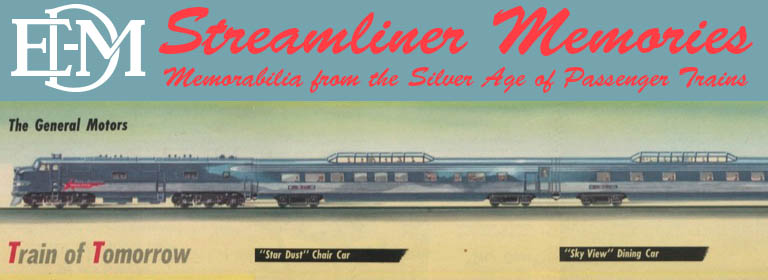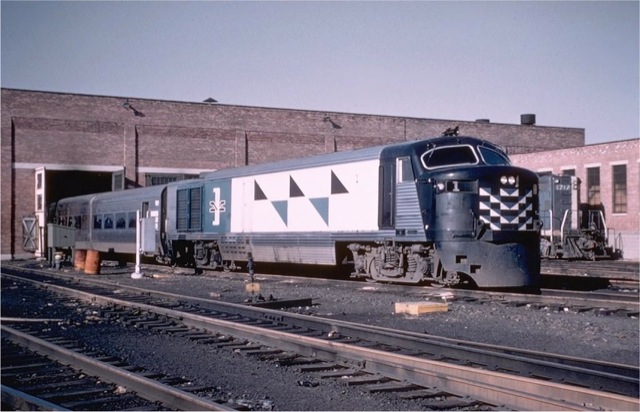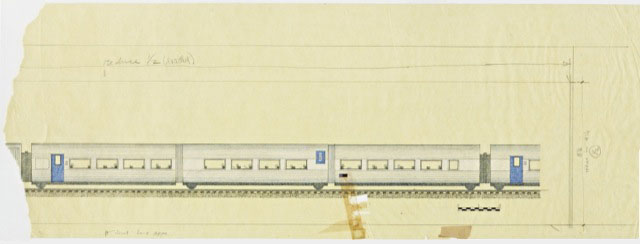In 1954, a flamboyant executive named Patrick McGinnis won control of the New Haven Railroad in a proxy battle. He promised improved passenger service, but he gave also large pay increases to his executive staff; hired his wife, Lucille, to help design new trains; saved money by deferring maintenance on the railroad; and ended up in jail for cheating railroad investors.
The Diesels in each Fairbanks-Morse P-12-42 locomotive generated 1,600 horsepower, but 400 of them were used provide lights and other power for the train, so they were rated at 1,200 hp. The New Haven purchased two such locomotives to push/pull the John Quincy Adams between New York and Boston.
Before that happened, however, he spent $5 million on three new trains aimed at keeping his promise of improving passenger service in the Boston-New York corridor. All three trains were delivered in late 1956 and began service in late 1956 or early 1957–I haven’t been able to find exact dates. One of the trains, the John Quincy Adams, was an ACF Talgo train powered by Fairbanks-Morse locomotives.

The New Haven’s new logo designed by Herbert Matter. The logo was applied to locomotives and cars in endless variations of red, black, and white.
The cars were very similar to those used on the Jet Rocket: each car consisted of three units articulated together rolling on four axles. The train had five such cars (instead of the Jet Rocket‘s four), and none of the cars had a blunt end because each end of the train had a 1,000-horsepower F-M locomotive so there would be no need to turn the train at the end of its run.
This video shows many of the logos that Herbert Matter considered when designing a new image for the New Haven.
On the highly paid advice of his wife, McGinnis hired a designer named Herbert Matter to design a new logo for the railroad. Industrial designers consider Matter’s interspersion of red, white, and black to be a classic. McGinnis also hired an architect named Marcel Breuer to provide a consistent design for the three new trains.
The Boston & Maine’s Speed Merchant showing Marcel Breuer’s locomotive paint scheme and part of the first car of the train. Click image for a larger view of this Wikipedia commons photo.
After less than two years of McGinnis’ management, the on-time record for New Haven passenger trains fell to less than 65 percent, and the railroad faced a commuter revolt. Life magazine labeled McGinnis one of the most “wildly unpopular” men in the country. As a result, the company fired him before any of the new trains were delivered.
Photos of the 1956 ACF Talgo cars are hard to find, but Marcel Breuer’s drawing of one of the cars shows how they were configured. Though lettered for Boston & Maine, similar cars were used on the John Quincy Adams and Jet Rocket.
ACF and Fairbanks-Morse delivered the John Quincy Adams to the New Haven on February 12, 1957 and it entered service on March 25. Meanwhile, McGinnis took control of the Boston & Maine Railroad, and ordered a duplicate of the John Quincy Adams, which would be called the Speed Merchant, for Boston-to-Portland service. Again, he hired Breuer to help design the train. It appears that Breuer also designed the Boston & Maine’s modern logo.
The New Haven and Boston & Maine had the same experience with the Talgo cars as the Rock Island: passengers considered them uncomfortable and they were unpopular. The New Haven removed the train from Boston-New York service on June 5, 1958 and sold it to Spain in 1962. The Boston & Maine continued running its train until 1964. Soon after that, McGinnis was imprisoned for 18 months for selling B&M assets at less-than-market prices to a company that then sold them for much higher prices and gave McGinnis a kickback on its profits. Many suspect he engaged in similar practices on the New Haven. Whether he did or not, the Talgo-type trains he bought turned out to be a waste of money.



